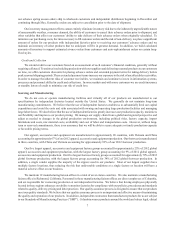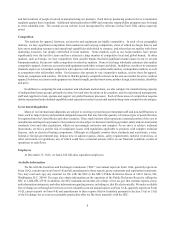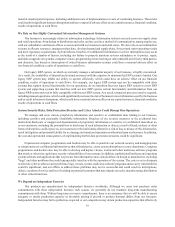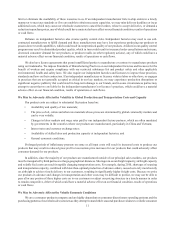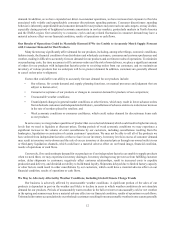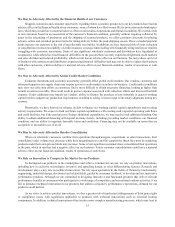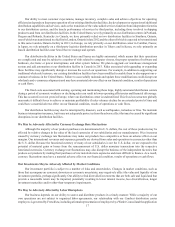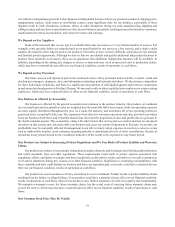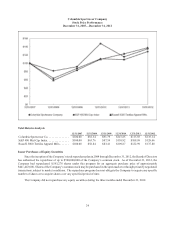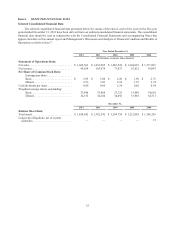Columbia Sportswear 2012 Annual Report Download - page 21
Download and view the complete annual report
Please find page 21 of the 2012 Columbia Sportswear annual report below. You can navigate through the pages in the report by either clicking on the pages listed below, or by using the keyword search tool below to find specific information within the annual report.17
Our ability to meet customer expectations, manage inventory, complete sales and achieve objectives for operating
efficiencies depends on the proper operation of our existing distribution facilities, the development or expansion of additional
distribution capabilities and services, such as the transition of the value added services function from independent factories
to our distribution centers, and the timely performance of services by third parties, including those involved in shipping
product to and from our distribution facilities. In the United States, we rely primarily on our distribution centers in Portland,
Oregon and Robards, Kentucky; in Canada, we have primarily relied on two distribution facilities in Strathroy, Ontario,
one of which was transitioned to a facility in London, Ontario in late 2012 and the other of which is expected to be transitioned
to this same London, Ontario facility in 2013; in Europe, we rely primarily on our distribution center in Cambrai, France;
in Japan, we rely primarily on a third-party logistics distribution provider in Tokyo; and in Korea, we rely primarily on
leased distribution facilities near Seoul that we manage and operate.
Our distribution facilities in the United States and France are highly automated, which means that their operations
are complicated and may be subject to a number of risks related to computer viruses, the proper operation of software and
hardware, electronic or power interruptions, and other system failures. We plan to upgrade our warehouse management
system and add automation at our distribution facility in Canada in 2013. Risks associated with upgrading or expanding
these facilities may significantly disrupt or increase the cost of our operations. For example, in addition to supporting our
traditional wholesale business, our existing distribution facilities have been modified to enable them to also support our e-
commerce business in the United States. Failure to successfully maintain and update these modifications could disrupt our
wholesale and e-commerce shipments and may have a material adverse effect on our financial condition, results of operations
or cash flows.
The fixed costs associated with owning, operating and maintaining these large, highly automated distribution centers
during a period of economic weakness or declining sales can result in lower operating efficiencies and financial deleverage.
This has occurred in recent years in Europe, where our distribution center is underutilized. This fixed cost structure globally
may make it difficult for us to achieve or maintain profitability if sales volumes decline for an extended period of time and
could have a material adverse effect on our financial condition, results of operations or cash flows.
Our distribution facilities may also be interrupted by disasters, such as earthquakes, tornadoes or fires. We maintain
business interruption insurance, but it may not adequately protect us from the adverse effect that may be caused by significant
disruptions in our distribution facilities.
We May be Adversely Affected by Currency Exchange Rate Fluctuations
Although the majority of our product purchases are denominated in U.S. dollars, the cost of these products may be
affected by relative changes in the value of the local currencies of our subsidiaries and our manufacturers. Price increases
caused by currency exchange rate fluctuations may make our products less competitive or have an adverse effect on our
margins. Our international revenues and expenses generally are derived from sales and operations in currencies other than
the U.S. dollar. Because the functional currency of many of our subsidiaries is not the U.S. dollar, we are exposed to the
potential of material gains or losses from the remeasurement of U.S. dollar monetary transactions into the respective
functional currencies. Currency exchange rate fluctuations may also disrupt the business of the independent factories that
produce our products by making their purchases of raw materials more expensive and more difficult to finance. As a result,
currency fluctuations may have a material adverse effect on our financial condition, results of operations or cash flows.
Our Investments May be Adversely Affected by Market Conditions
Our investment portfolio is subject to a number of risks and uncertainties. Changes in market conditions, such as
those that accompany an economic downturn or economic uncertainty, may negatively affect the value and liquidity of our
investment portfolio, perhaps significantly. Our ability to find diversified investments that are both safe and liquid and that
provide a reasonable return may be impaired, potentially resulting in lower interest income, less diversification, longer
investment maturities and/or other-than-temporary impairments.
We May be Adversely Affected by Labor Disruptions
Our business depends on our ability to source and distribute products in a timely manner. While a majority of our
own operations are not subject to organized labor agreements, our relationship with our Cambrai distribution center
employees is governed by French law, including a formal representation of employees by a Works' Council and the application


